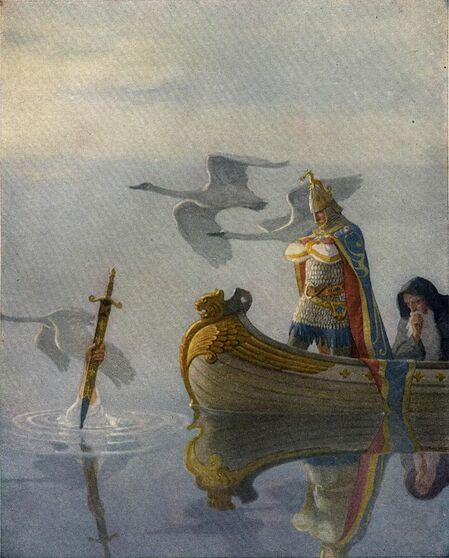|
There are two famous accounts of how King Arthur won his sword.
This has led to some confusion. Different sources may use one sword or the other or both. In many works, such as the 1981 film Excalibur and the 1998 miniseries Merlin, the two swords are one and the same. This has caused a reactionary response: these should properly be two different weapons, wielded by Arthur at different times. On a DeviantArt submission in 2006, multiple users bobbed in to remark that Excalibur, the sword from the lake, was not the same as the Sword in the Stone. A 2014 post on StackExchange said much the same thing. The sword in the stone, according to sources like these, is actually called Clarent. Going back to the earliest sources: Arthur's sword in Welsh was named Caledfwlch. This could have developed into Excalibur. That's another debate. Throughout the history of Arthurian legend, Excalibur (or Caliburn, Caliburnus, Escalibor, Chalabrum, etc.) has always been The Arthurian Sword. King Arthur bears it, or one of his champions like Gawaine wields it for him. The Sword in the Stone appears in Robert de Boron's Merlin, but doesn't get a name. In the Vulgate Merlin Continuation, Escalibor is the sword pulled from the stone, which Arthur eventually passes down to Gawain. In the post-Vulgate Suite du Merlin, they are separate swords. The sword from the stone is broken, and Arthur receives Escalibor from the lake as a replacement. The Suite also introduces Excalibur's magical scabbard. In Thomas Malory's Morte d' Arthur, drawing from many Arthurian sources, Arthur draws the sword from the stone. It is not named until Chapter IX, where it's called "Excalibur," shining with "light like thirty torches." This sword eventually breaks, and the Lady of the Lake gives Arthur . . . another sword named Excalibur. Malory's pretty inconsistent throughout this work. It may be that he included Excalibur's name early on by mistake. All the same, here it seems that Arthur had two separate swords and both were named Excalibur. Now for Clarent. Clarent appears in one source: the Alliterative Morte Arthur. It is Arthur's beloved, sacred sword used only in ceremonies and knightings. Arthur views it with reverence and uses his other sword, Caliburn, for battle. Mordred gains Clarent through his treachery and, eventually, slays Arthur with it. There are a few possible sources for the name. In the Estoire de Merlin, Arthur uses the battlecry "Clarent." There was also a city of Clarent in Sorgalles that was part of Arthur's dominion. An interesting similarity exists in the romance The history of the valiant knight Arthur of Little Britain, where a knight named Arthur wins a sword called Clarence. But nowhere else does Clarent appear, and it is never identified as the sword in the stone. It has generally survived as a footnote. In 1895, Selections from Tennyson described it rather dismissively as Arthur's "second-best sword"! However, some Arthurian scholars have taken note of it. In 1960, William Matthews theorized that the Alliterative Morte's two swords were an attempt to reconcile confusing accounts of what swords Arthur used and when. "[I]t seems likely that [Clarent] may be the sword-in-the-stone . . . and that Caliburn is, as usual (though not always), the sword of the Lady of the Lake." Similarly, Kathleen Toohey reviews Arthur's reverential treatment of the sword: "from what we learn of Clarent no better role could have been found for the sword in the stone than the one assigned to Clarent." Note those phrases, though: "It seems likely." "Not always." "From what we learn." "Could have been." Anyone who ties the obscure name Clarent to the sword in the stone is theorizing. It's a valid theory, but still a theory. There's no solid evidence for it. Unhelpfully, for some time there was a Wikipedia article identifying Clarent as the Sword in the Stone. It was nominated for deletion in September 2012. Clarent has gotten a popularity boost in recent years. It's shown as Mordred's sword in the Japanese light novel Fate/Apocrypha (2012-2014). Its origin is very close to that of the canonical Clarent, but I can't find any mention of it being the Sword in the Stone. There are alternate options. Nightbringer, an extensive online Arthurian dictionary, suggests that the sword in the stone could be identified with Sequence, another sword belonging to Arthur, which was borrowed by Lancelot. Alternately, based on romances where Gawaine inherits Arthur's first sword, maybe the sword he wields in Malory - "Galatine" - is the original sword in the stone. (I don't quite follow this, since in those romances the original sword is Escalibor.) These guesses hit the same issues as the Clarent theory: namely, they're guesses. We have a confusion of sources where Excalibur is sometimes the Sword in the Stone and sometimes its replacement. Or, as in Malory, both! Ultimately, the Sword in the Stone cannot be definitively linked to Clarent, Sequence, Galatine, or any of the swords belonging to Arthur . . . except for Excalibur. Sources
Text copyright © Writing in Margins, All Rights Reserved
3 Comments
Gary
7/26/2021 11:16:15 am
I had thought that they were two different swords; however, and I really cannot recall where I got this from, but I had also read/seen in one story that the sword in the stone had been broken and was taken to the lady in the lake (by Merlin?) who then fixed it. Therefore, in that story, Excalibur is actually one and the same sword, given to Arthur firstly via the stone and then later by the lady in the lake.
Reply
Robert Gordon
11/13/2022 01:34:00 am
Strange women lying in lakes, distributing swords is no basis for a system of government
Reply
1/11/2023 10:18:59 pm
Still better than the Electoral College, though: https://nationalpopularvote.org
Reply
Leave a Reply. |
About
Researching folktales and fairies, with a focus on common tale types. Archives
July 2024
Categories
All
|
Writing in Margins

 RSS Feed
RSS Feed
